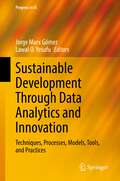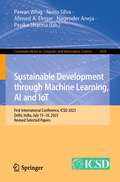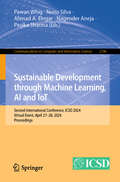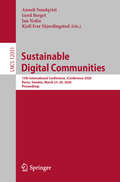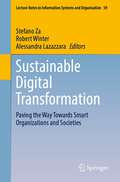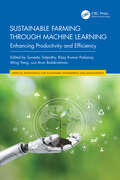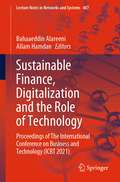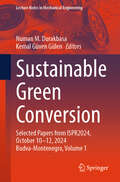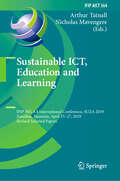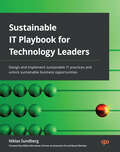- Table View
- List View
Sustainable Development Through Data Analytics and Innovation: Techniques, Processes, Models, Tools, and Practices (Progress in IS)
by Jorge Marx Gómez Lawal O. YesufuSustainable development is based on the idea that societies should advance without compromising their future development requirements. This book explores how the application of data analytics and digital technologies can ensure that development changes are executed on the basis of factual data and information. It addresses how innovations that rely on digital technologies can support sustainable development across all sectors and all social, economic, and environmental aspects and help us achieve the Sustainable Development Goals (SDGs). The book also highlights techniques, processes, models, tools, and practices used to achieve sustainable development through data analysis. The various topics covered in this book are critically evaluated, not only theoretically, but also from an application perspective. It will be of interest to researchers and students, especially those in the fields of applied data analytics, business intelligence and knowledge management.
Sustainable Development Using Private AI: Security Models and Applications (Artificial Intelligence for Sustainable Engineering and Management)
by Rajanikanth Aluvalu Uma Maheswari VThis book covers the fundamental concepts of private AI and its applications. It also covers fusion of Private AI with cutting-edge technologies like cloud computing, federated learning and computer vision.Security Models and Applications for Sustainable Development Using Private AI reviews various encryption algorithms used for providing security in private AI. It discusses the role of training machine learning and Deep learning technologies in private AI. The book provides case studies of using private AI in various application areas such as purchasing, education, entertainment, medical diagnosis, predictive care, conversational personal assistants, wellness apps, early disease detection, and recommendation systems. The authors provide additional knowledge to handling the customer’s data securely and efficiently. It also provides multi-model dataset storage approaches along with the traditional approaches like anonymization of data and differential privacy mechanisms.The target audience includes undergraduate and postgraduate students in Computer Science, Information technology, Electronics and Communication Engineering and related disciplines. This book is also a one stop reference point for professionals, security researchers, scholars, various government agencies and security practitioners, and experts working in the cybersecurity Industry specifically in the R & D division.
Sustainable Development and Innovation of Digital Enterprises for Living with COVID-19
by Subhankar Das Subhra R Mondal Jana MajerovaThis book explores the implications of descriptive, predictive, and prescriptive digital enterprises and their practices for different functional domains and in different counties during COVID-19. This book will bring new dimensions of study to the concept of digital enterprises which is sure to change after COVID-19 as it has upended the way in which people work, live and communicate. Covering a broad range of topics related to digital enterprises, this book is meant for business owners, digital professionals, managers, researchers, and academics who are seeking to integrate digital enterprises in order to allow organizations and countries to stay on a sustainable development trajectory while living with COVID-19.
Sustainable Development in Changing Complex Earth Systems (Sustainable Development Goals Series)
by Attila Kerényi Richard William McIntoshThis book applies system theory to analyze the operation and structure of the complex earth surface system, including the interactions between society and nature that cause environmental degradation and threats to human populations. The possible ways to harmonize the operation of a global society as a complex system using the United Nation sustainable development goals are investigated, as well as the major efforts currently implemented to achieve this objective and why many are unsuccessful. Readers will learn this material through case studies that assess the essential conditions required to occupy a planet sustainably, and examine the complex interactions between society and nature in the atmosphere, hydrosphere, biosphere, and outer layers of the lithosphere. The book is written for undergraduate students in geography, earth sciences, environmental sciences, and ecology, and will also appeal to environmental agency employees, nature protection representatives, teachers, and researchers.
Sustainable Development through Machine Learning, AI and IoT: First International Conference, ICSD 2023, Delhi, India, July 15–16, 2023, Revised Selected Papers (Communications in Computer and Information Science #1939)
by Ahmed A. Elngar Pawan Whig Nuno Silva Nagender Aneja Pavika SharmaThis book constitutes the revised selected papers of the First International Conference, ICSD 2023, virtually held in Delhi, India, during July 15–16, 2023.The book comprises 31 full papers that were selected from a total of 129 submissions. It provides insights into the latest research and advancements in sustainable development through the integration of machine learning, artificial intelligence, and IoT technologies. It serves as a valuable resource for researchers, practitioners, and policymakers working in the field of sustainable development.
Sustainable Development through Machine Learning, AI and IoT: Second International Conference, ICSD 2024, Virtual Event, April 27–28, 2024, Proceedings (Communications in Computer and Information Science #2196)
by Pawan Whig Nuno Silva Nagender Aneja Pavika Sharma Ahmad A. ElngarThis book constitutes the refereed proceedings of the Second International Conference on Sustainable Development through Machine Learning, AI and IoT, ICSD 2024, held in Virtual Event, during April 27–28, 2024. The 38 full papers presented here were carefully reviewed and selected from 167 submissions. These papers have been categorized into the following sections: This volume encompassing a diverse array of topics at the intersection of cutting-edge technologies and practical applications. Each chapter delves into innovative approaches and solutions, providing valuable insights into contemporary challenges and opportunities in various domains. Here, we explore the realms of blockchain, data science, machine learning, artificial intelligence, and more, offering in-depth analyses and practical implementations.
Sustainable Digital Communities: 15th International Conference, iConference 2020, Boras, Sweden, March 23–26, 2020, Proceedings (Lecture Notes in Computer Science #12051)
by Anneli Sundqvist Gerd Berget Jan Nolin Kjell Ivar SkjerdingstadThis volume constitutes the proceedings of the 15th International Conference on Sustainable Digital Communities, iConference 2020, held in Boras, Sweden, in March 2020. The 27 full papers and the 48 short papers presented in this volume were carefully reviewed and selected from 178 submissions. They cover topics such as: sustainable communities; social media; information behavior; information literacy; user experience; inclusion; education; public libraries; archives and records; future of work; open data; scientometrics; AI and machine learning; methodological innovation.
Sustainable Digital Marketing for Fashion and Luxury Brands: Theory and Practice
by Wilson Ozuem Silvia Ranfagni Cindy MillmanThis book critically examines the evolving fashion and luxury brand sector in the post-COVID-19 era, emphasizing the crucial need for sustainable digital marketing strategies and innovation. The book explores the dual commitment luxury brands face, balancing social and ethical responsibilities while preserving product quality, skill, and exclusivity. It explores how brands navigate internal capability development and engage in community projects to contribute positively to social causes. From the restructuring of luxury around digital communication to the transformative impact of technologies, the book dissects the challenges and opportunities. It addresses the essential resources, knowledge management, and organizational changes required for successful digital adoption, highlighting the confluence of sustainable orientation with technological and organizational shifts in the fashion and luxury sector. As luxury undergoes a paradigm shift, this book offers a comprehensive analysis of its sustainable evolution amidst the digital transformation. Chapter 24 is available open access under a Creative Commons Attribution 4.0 International License via link.springer.com.
Sustainable Digital Transformation: Paving the Way Towards Smart Organizations and Societies (Lecture Notes in Information Systems and Organisation #59)
by Stefano Za Alessandra Lazazzara Robert WinterDigital transformation is one of the most discussed topics today because of its impact on society and the economy. This book explores how digital transformation can be made sustainable and how sustainability strategies can be integrated into the different phases of digital transformation development. It shows how ICT experts, managers, and policy makers can contribute to a sustainable digital transformation by examining the technological, organizational, and societal implications. The book is based on a selection of best papers on this topic presented at the annual conference of the Italian Chapter of AIS in Trento, Italy, in October 2021.The plurality of views offered makes the book particularly relevant for scholars, companies, and organizations in the public sector.
Sustainable Energy Solutions with Artificial Intelligence, Blockchain Technology, and Internet of Things (Smart Technologies for Engineers and Scientists)
by Brian Azzopardi Abhinav Sharma Arpit Jain Vibhu JatelyThe text provides sustainable energy solutions using smart technologies such as artificial intelligence, blockchain technology, and the Internet of Things. It further presents several case studies on applications of the Internet of Things, artificial intelligence, and blockchain technology in the field of sustainable energy. Focuses on the integration of smart technology including artificial intelligence and sustainable energy Covers recent advancements in energy management techniques used in residential and commercial energy systems Highlights the use of artificial intelligence, machine learning, and their applications in sustainable energy Discusses important topics such as green energy, grid modernization, smart security in the power grid, and fault diagnosis Presents case studies on the applications of the Internet of Things, blockchain, and artificial intelligence in sustainable energy The text showcases the latest advancements, and the importance of technologies including artificial intelligence, blockchain, and Internet of Things in achieving sustainable energy systems. It further discusses the role of machine learning, applied deep learning, and edge computing in renewable energy. The text cover key concepts such as intelligent battery management system, energy trading, green energy, grid modernization, electric vehicles, and charging station optimization. It will serve as an ideal reference text for senior undergraduate, graduate students, and academic researchers in the fields including electrical engineering, electronics and communication engineering, computer engineering, and environmental engineering.
Sustainable Energy for Smart Cities: 4th EAI International Conference, SESC 2022, Braga, Portugal, November 16-18, 2022, Proceedings (Lecture Notes of the Institute for Computer Sciences, Social Informatics and Telecommunications Engineering #502)
by João L. Afonso José Gabriel Pinto Vitor MonteiroThis book constitutes the refereed post-conference proceedings of the 4th EAI International Conference on Sustainable Energy for Smart Cities, SESC 2022, held in Braga, Portugal, in November 2022. The 10 revised full papers were carefully reviewed and selected from 29 submissions. They present multidisciplinary scientific results toward answering complex technological problems of emergent Smart Cities. The subjects related to sustainable energy, framed with the scope of smart cities and addressed along with the SESC 2022 conference, are crucial to guarantee an equilibrium among economic growth and environmental sustainability, as well as to contribute to reducing the impact of climate change.
Sustainable Energy for Smart Cities: First EAI International Conference, SESC 2019, Braga, Portugal, December 4–6, 2019, Proceedings (Lecture Notes of the Institute for Computer Sciences, Social Informatics and Telecommunications Engineering #315)
by João L. Afonso Vítor Monteiro José Gabriel PintoThis book constitutes the refereed post-conference proceedings of the First EAI International Conference on Sustainable Energy for Smart Cities, SESC 2029, held as part of the Smart City 360° Summit event in Braga, Portugal, in December 2019. The 23 revised full papers were carefully reviewed and selected from 38 submissions. They contribute to answer complex societal, technological, and economic problems of emergent smart cities. The papers are organized thematically in tracks, starting with mobile systems, cloud resource management and scheduling, machine learning, telecommunication systems, and network management. The papers are grouped in topical sections on electric mobility; power electronics; intelligent, transportation systems; demand response; energy; smart homes; Internet of Things; monitoring; network communications; power quality; power electronics.
Sustainable Energy for Smart Cities: Second EAI International Conference, SESC 2020, Viana do Castelo, Portugal, December 4, 2020, Proceedings (Lecture Notes of the Institute for Computer Sciences, Social Informatics and Telecommunications Engineering #375)
by João L. Afonso José Gabriel Pinto Vitor MonteiroThis book constitutes the refereed post-conference proceedings of the Second EAI International Conference on Sustainable Energy for Smart Cities, SESC 2020, held in Portugal in December 2020. The conference was framed within the 6th Annual Smart City 360° Summit. Due to COVID-19 pandemic the conferences were held virtually.The 13 revised full papers were carefully reviewed and selected from 27 submissions. They present multidisciplinary scientific results toward answering the complex technological problems of emergent Smart Cities. The subjects related to sustainable energy, framed with the scope of smart cities and addressed along with the SESC 2020 conference, are crucial to guarantee an equilibrium among economic growth and environmental sustainability, as well as to contribute to reducing the impact of climate change.
Sustainable Energy for Smart Cities: Third EAI International Conference, SESC 2021, Virtual Event, November 24–26, 2021, Proceedings (Lecture Notes of the Institute for Computer Sciences, Social Informatics and Telecommunications Engineering #425)
by José Gabriel Pinto Vitor Monteiro Joao L. AfonsoThis book constitutes the refereed post-conference proceedings of the 3rd EAI International Conference on Sustainable Energy for Smart Cities, SESC 2021, held in November 2021. The conference was framed within the 7th Annual Smart City 360° Summit. Due to COVID-19 pandemic the conferences were held virtually. The 13 revised full papers were carefully reviewed and selected from 28 submissions. They present multidisciplinary scientific results toward answering the complex technological problems of emergent Smart Cities. The subjects related to sustainable energy, framed with the scope of smart cities and addressed along with the SESC 2021 conference, are crucial to guarantee an equilibrium among economic growth and environmental sustainability, as well as to contribute to reducing the impact of climate change.
Sustainable Enterprise Architecture
by Kirk HausmanEnterprise architecture requires an understanding of all technologies, strategies, and data consumption throughout the enterprise. To this end, one must strive to always broaden knowledge of existing, as well as emerging trends and solutions. As a trade, this role demands an understanding beyond the specificities of technologies and vendor products
Sustainable Farming through Machine Learning: Enhancing Productivity and Efficiency (Artificial Intelligence for Sustainable Engineering and Management)
by Ming Yang Suneeta Satpathy Arun Balakrishnan Bijay Kumar PaikarayThis book explores the transformative potential of machine learning (ML) technologies in agriculture. It delves into specific applications, such as crop monitoring, disease detection, and livestock management, demonstrating how artificial intelligence/machine learning (AI/ML) can optimize resource management and improve overall productivity in farming practices.Sustainable Farming through Machine Learning: Enhancing Productivity and Efficiency provides an in-depth overview of AI and ML concepts relevant to the agricultural industry. It discusses the challenges faced by the agricultural sector and how AI/ML can address them. The authors highlight the use of AI/ML algorithms for plant disease and pest detection and examine the role of AI/ML in supply chain management and demand forecasting in agriculture. It includes an examination of the integration of AI/ML with agricultural robotics for automation and efficiency. The authors also cover applications in livestock management, including feed formulation and disease detection; they also explore the use of AI/ML for behavior analysis and welfare assessment in livestock. Finally, the authors also explore the ethical and social implications of using such technologies.This book can be used as a textbook for students in agricultural engineering, precision farming, and smart agriculture. It can also be a reference book for practicing professionals in machine learning, and deep learning working on sustainable agriculture applications.
Sustainable Finance, Digitalization and the Role of Technology: Proceedings of The International Conference on Business and Technology (ICBT 2021) (Lecture Notes in Networks and Systems #487)
by Allam Hamdan Bahaaeddin AlareeniThis book constitutes the refereed proceedings of the International Conference on Business and Technology (ICBT2021) organized by EuroMid Academy of Business & Technology (EMABT), held in Istanbul, between 06–07 November 2021. In response to the call for papers for ICBT2021, 485 papers were submitted for presentation and inclusion in the proceedings of the conference. After a careful blind refereeing process, 292 papers were selected for inclusion in the conference proceedings from forty countries. Each of these chapters was evaluated through an editorial board, and each chapter was passed through a double-blind peer-review process.The book highlights a range of topics in the fields of technology, entrepreneurship, business administration, accounting, and economics that can contribute to business development in countries, such as learning machines, artificial intelligence, big data, deep learning, game-based learning, management information system, accounting information system, knowledge management, entrepreneurship, and social enterprise, corporate social responsibility and sustainability, business policy and strategic management, international management and organizations, organizational behavior and HRM, operations management and logistics research, controversial issues in management and organizations, turnaround, corporate entrepreneurship, innovation, legal issues, business ethics, and firm governance, managerial accounting and firm financial affairs, non-traditional research, and creative methodologies.These proceedings are reflecting quality research contributing theoretical and practical implications, for those who are wise to apply the technology within any business sector. It is our hope that the contribution of this book proceedings will be of the academic level which even decision-makers in the various economic and executive-level will get to appreciate.
Sustainable Green Conversion: Selected Papers from ISPR2024, October 10-12, 2024 Budva-Montenegro, Volume 1 (Lecture Notes in Mechanical Engineering)
by Numan M. Durakbasa Kemal Güven GülenThis book contains the first volume of selected papers from International Symposium for Production Research 2024, held on October 10–12, 2024, in Budva, Montenegro. The book reports recent advances in production engineering and operations. This year's conference had the overarching theme of "Sustainable Green Conversion." The book explores topics including: Invited Articles, Artificial Intelligence Applications, Industrial Applications, Industry 4.0 and Industry 5.0 Applications, Operations Research Applications, Production Management, Productivity and Performance Management and Quality Management. Presenting real-life applications, case studies, and mathematical models, this book is of interest to researchers, academics, and practitioners in the field of production and operation engineering. It provides both the results of recent research and practical solutions to real-world problems.
Sustainable Green Conversion: Selected Papers from ISPR2024, October 10-12, 2024, Budva, Montenegro, Volume 2 (Lecture Notes in Mechanical Engineering)
by Numan M. Durakbasa Kemal Güven GülenThis book contains the second volume of selected papers from International Symposium for Production Research 2024, held on October 10–12, 2024, in Budva, Montenegro. The book reports recent advances in production engineering and operations. This year's conference had the overarching theme of "Sustainable Green Conversion." The book explores topics including: Simulation and Modelling, Supply Chain and Logistics Management, Sustainability and Capstone Projects. Presenting real-life applications, case studies, and mathematical models, this book is of interest to researchers, academics, and practitioners in the field of production and operation engineering. It provides both the results of recent research and practical solutions to real-world problems.
Sustainable Horizons for Business, Education, and Technology: Interdisciplinary Insights (Contributions to Environmental Sciences & Innovative Business Technology)
by Allam Hamdan Hashem Alshurafat John SandsThis book offers a detailed analysis of the intersection of sustainability, innovation, and global progress, and it comprehensively explores sustainable practices and their impact on business, education, and technology. The book shows how businesses can incorporate sustainability into their core operations, including environment-friendly supply chains, renewable energy adoption, circular economy models, ethical decision-making, and sustainable growth strategies. Successful sustainable businesses and the benefits of their socially responsible practices are highlighted. In addition, the book explores how education can shape a sustainable future. It is necessary to integrate the ideas of sustainability into the curricula of early childhood education to higher learning institutions to educate and empower the next generation of changemakers. The role of technology in advancing sustainability efforts is also investigated, including artificial intelligence, blockchain, clean energy solutions, green architecture, and smart cities. Other topics explored in the book include global sustainability efforts such as international collaborations, public-private partnerships, and multilateral initiatives; the role of governments, NGOs, and international organizations in promoting sustainable development; ethical considerations and social impacts of sustainable practices, for example, social justice, inclusivity, and environmental stewardship; connections between sustainable development and improved quality of life; and groundbreaking ideas and innovations for industries to tackle sustainability issues. The book offers a comprehensive and forward-looking perspective on sustainability. By combining different viewpoints, the book empowers readers with the knowledge and inspiration to contribute meaningfully to a more sustainable, inclusive, and resilient world.
Sustainable ICT, Education and Learning: IFIP WG 3.4 International Conference, SUZA 2019, Zanzibar, Tanzania, April 25–27, 2019, Revised Selected Papers (IFIP Advances in Information and Communication Technology #564)
by Arthur Tatnall Nicholas MavengereThis book constitutes the refereed post-conference proceedings of the First IFIP WG 3.4 International Conference on Sustainable ICT, Education, and Learning, SUZA 2019, held in Zanzibar, Tanzania, in April 2019, in conjunction with the 15th IFIP WG 9.4 International Conference on Social Implications of Computers in Developing Countries.The 27 revised full papers presented in this volume were carefully reviewed and selected from 41 submissions. The papers cover topics such as peer and collaborative learning in informatics; pedagogical approaches to teaching specific informatics courses; workplace learning related to information systems; e-learning; ICTs for development; mobile solutions in learning in the North and South; lifelong learning; applications for disabled students; traversal skills and computational thinking; and teacher education in the global South.
Sustainable IT Architecture: The Progressive Way of Overhauling Information Systems with SOA (Wiley-iste Ser.)
by Pierre Bonnet Dominique Vauquier Jean-Michel DetavernierThis book focuses on Service Oriented Architecture (SOA), the basis of sustainable and more agile IT systems that are able to adapt themselves to new trends and manage processes involving a third party. The discussion is based on the public Praxeme method and features a number of examples taken from large SOA projects which were used to rewrite the information systems of an insurance company; as such, decision-makers, creators of IT systems, programmers and computer scientists, as well as those who will use these new developments, will find this a useful resource.
Sustainable IT Playbook for Technology Leaders: Design and implement sustainable IT practices and unlock sustainable business opportunities
by Niklas Sundberg Helene BarnekowAt a critical point in human history, this book presents proven ways to gain the skills needed to develop sustainable IT practices and set yourself apart as a progressive technology leaderKey FeaturesExecute a sustainable IT strategy with proven methods and real-world use casesProgress as a sustainable IT advocate and set yourself apart from other senior IT leadersIncrease your chances of receiving executive buy-in on your sustainable IT strategyBook DescriptionWe are at a critical point in human history. Humanity is under threat, but all is not lost. We can take action! But how?Sustainable IT Playbook for Technology Leaders will show you how. It will walk you through the construction and implementation of a sustainable IT strategy and enable you to do your bit for the future of mankind.The book is split into three parts. Part I details the “why” and the clear and present danger that humanity faces today: the climate crisis. How did we get here, what are the immediate threats, what are the planetary boundaries that we need to peel back to safe levels, and what impact does IT have on society at large? Part II will focus on the "what.” It examines the nitty-gritty details of what we can do to unlock significant returns on sustainable investments toward a more sustainable future. Part III, the final part of the book, focuses on the “how.” How do you turn your ideas into action? What do you need to do to establish your baseline and your direction of travel towards your objective? This part provides tangible case studies and explains how you can start your journey today to begin delivering global and impactful objectives.By the end of this book, you'll be able to plan, implement, and communicate a sustainable IT strategy and set yourself apart as a progressive technology leader.What you will learnDiscover why IT is a major contributor to carbon emissionsExplore the principles and key methods of sustainable IT practicesBuild a robust, sustainable IT strategy based on proven methodsOptimize and rationalize your code to consume fewer resourcesUnderstand your energy consumption patternsApply a circular approach to the IT hardware life cycleEstablish your sustainable IT baselineInspire and engage employees, customers, and stakeholdersWho this book is forThis book is for executive IT leaders such as CIOs, CDOs, and CTOs dedicated to influencing, inspiring, and engaging businesses, organizations, and individuals to reduce their carbon footprint through sustainable IT practices.
Sustainable Intelligent Systems (Advances in Sustainability Science and Technology)
by Amit Joshi Atulya K. Nagar Gabriela Marín-RaventósThis book discusses issues related to ICT, intelligent systems, data science, AI, machine learning, sustainable development and overall their impacts on sustainability. It provides an overview of the technologies of future. The book also discusses novel intelligent algorithms and their applications to move from a data-centric world to sustainable world. It includes research paradigms on sustainable development goals and societal impacts. The book provides an overview of cutting-edge techniques toward sustainability and ideas to help researchers who want to understand the challenges and opportunities of using smart management perspective for sustainable society. It serves as a reference to wide ranges of readers from computer science, data analysts, AI technocrats and management researchers.
Sustainable Interdependent Networks II: From Smart Power Grids to Intelligent Transportation Networks (Studies in Systems, Decision and Control #186)
by Panos M. Pardalos Frede Blaabjerg Kianoosh G. Boroojeni M. Hadi Amini S. S. Iyengar Asad M. MadniThis book paves the way for researchers working on the sustainable interdependent networks spread over the fields of computer science, electrical engineering, and smart infrastructures. It provides the readers with a comprehensive insight to understand an in-depth big picture of smart cities as a thorough example of interdependent large-scale networks in both theory and application aspects. The contributors specify the importance and position of the interdependent networks in the context of developing the sustainable smart cities and provide a comprehensive investigation of recently developed optimization methods for large-scale networks. There has been an emerging concern regarding the optimal operation of power and transportation networks. In the second volume of Sustainable Interdependent Networks book, we focus on the interdependencies of these two networks, optimization methods to deal with the computational complexity of them, and their role in future smart cities. We further investigate other networks, such as communication networks, that indirectly affect the operation of power and transportation networks. Our reliance on these networks as global platforms for sustainable development has led to the need for developing novel means to deal with arising issues. The considerable scale of such networks, due to the large number of buses in smart power grids and the increasing number of electric vehicles in transportation networks, brings a large variety of computational complexity and optimization challenges. Although the independent optimization of these networks lead to locally optimum operation points, there is an exigent need to move towards obtaining the globally-optimum operation point of such networks while satisfying the constraints of each network properly. The book is suitable for senior undergraduate students, graduate students interested in research in multidisciplinary areas related to future sustainable networks, and the researchers working in the related areas. It also covers the application of interdependent networks which makes it a perfect source of study for audience out of academia to obtain a general insight of interdependent networks.
